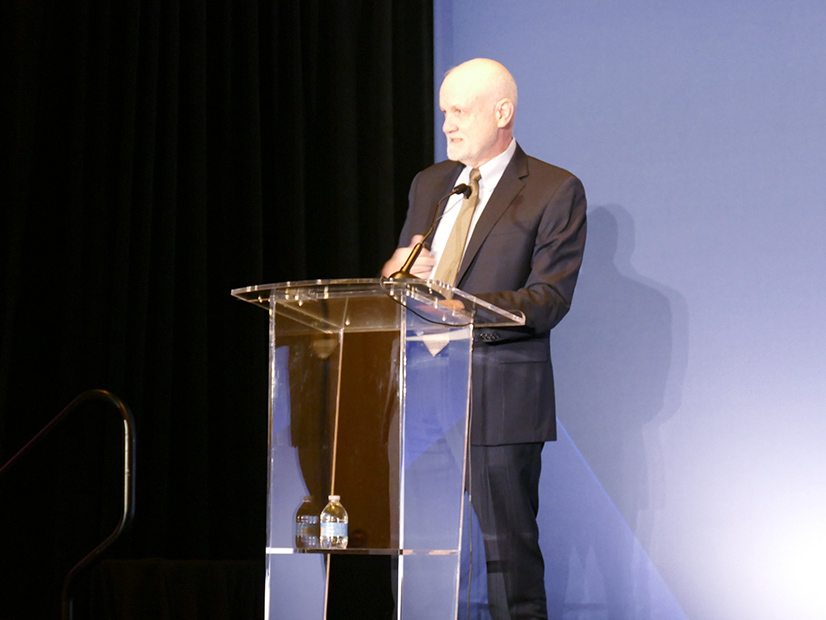WASHINGTON — The ongoing turnover of the generation fleet to cleaner resources, the recent return of demand growth and the need to stitch all that together with transmission expansion all came up at the Energy Bar Association’s Annual Meeting.
“We’re at a major inflection point in the development and maturation of the electric utility industry,” MISO Assistant General Counsel Michael Kessler said. “And there are many factors that we are experiencing that are impacting almost all aspects of the industry.”
Studies by MISO and others have found the grid can be operated reliably even with higher levels of intermittent resources, but until new technologies are available, those renewables will need to be balanced with more traditional, dispatchable resources, he added.
“There’s a lot of uncertainty going forward in kind of managing this transition,” said Analysis Group Principal Todd Schatzki. “And in many cases, the speed at which things are happening is very uncertain. Some things [that] we think are going to happen very quickly are taking longer. And some things we don’t anticipate are suddenly coming in very quickly. The whole data center issue, AI and how that’s changing things, is a classic example of that.”
While the system is changing and regulators and the industry are working to address that, there is still substantial uncertainty about the pace of change, Alliant Energy Executive Vice President Raja Sundararajan said. Electric vehicle demand was supposed to grow at a steady clip, but now it varies by region and is slowing down in some, he said.
“There’s a natural skepticism: Are we going to overbuild?” Sundararajan said. “And if you’re going to overbuild, then you have the affordability issue that comes into play, where the regulators are saying, ‘Why should … customers pay a portion of the cost for [a] new set of customers? And how do I transfer the risk between existing customers and the new customer?’”
Basic regulatory processes need to speed up, he added, citing transmission and developing integrated resource plans.
FERC has a major rule coming May 13 aimed at improving transmission planning and cost allocation. Commissioner Mark Christie is a key vote there, but he declined to wade into the debate when asked after his speech at the conference. He did make clear he continues to favor a strong role for the states and wants to make sure the changes do not impose unneeded costs on customers.
While states have to site transmission lines, they do not get to decide what consumers will pay for them because that falls under FERC’s regulatory territory, he said.
“I’m very adamant that in any transmission planning that FERC is going to mandate, if you’re going to put policy-oriented projects in there, the states have to have the ability to consent to it,” Christie said. “So, we can restore the balance, which we have not had really for 20 years, where state regulators have the role that they should have in determining the transmission costs and how they get passed on to consumers.”
Risks are inherent in long-term planning, but it still is work that needs to be done, said Grid Strategies President Rob Gramlich.
“A lot of people sort of end the conversation and say, ‘Well, we might be wrong,’” Gramlich said. “Well, of course. Look at this great industry that is still a marvel of modern society that has been developed and that we all inherited, where we can flip the switch and get the lights on. That was all planned. Guess what? Planners in the ’50s, ’60s and ’70s didn’t know what to expect.”
A lot of transmission was built just 10 years ago in 2013, when different efforts such as MISO’s first Multi-Value Projects and the Competitive Renewable Energy Zone lines in Texas came to fruition. But since then, it has “slowed to a trickle,” Gramlich said. “If you care a lot about the pace of climate action and greenhouse gas reductions — well, 80% of the most historic climate legislation ever will not be achieved without doubling the pace of transmission.”
FERC’s transmission rule is the culmination of years of work, which includes the Joint Task Force with states, said Karin Herzfeld, senior transmission counsel to Chair Willie Phillips.
“The NOPR was silent as to what happens when states cannot come to an agreement on the cost allocation for any particular project,” Herzfeld said. “And I know there’s some friction here, but the chairman, as a former state regulator, is focused on keeping states front and center on this important issue.”
Another issue on FERC’s plate is what to do about dynamic line ratings, on which it has an open Notice of Inquiry. On that front, Herzfeld told the EBA crowd to “stay tuned.”



